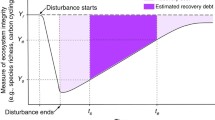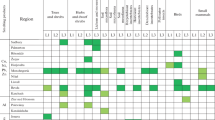Abstract
Effective environmental management practices reduce anthropogenic chemical impacts in ecosystems and lead to the onset of recovery. Recovery proceeds at different rates and to different extents at each level of biological organisation (molecular, cellular,individual, population, community, ecosystem).Consequently, environmental assessments made at one level of organisation may not indicate the progress of recovery processes at other levels. The course of recovery of populations and communities is usually monitored using routine ecological procedures. As pollutant exposure often results in residual effects which may influence the subsequent ability of ecosystems and their components to respond to new environmental challenges, it is proposed that a more relevant strategy would be to measure biomarkers to assess recovery at the individual level and below,determine pollution induced community tolerance and analyse community composition.
It is also proposed that environmental managers aim tore-establish essential and desirable features of ecosystems (important structural components and functions (nutrient cycling, biodegradation rates,etc), restore biodiversity), rather than attempting to achieve full recovery, as the latter may waste valuable resources.
Similar content being viewed by others
References
Anderson, D.W., F. Gress & D.M. Fry, 1996. Survival and dispersal of oiled brown pelicans after rehabilitationand release. Marine Pollution Bulletin 32: 711–718.
Anderson, J.R. (ed.), 1980. Muir’s Textbook of Pathology. Edward Arnold (Publishers) Ltd, London, 1112 pp.
Babich, H.R., R.J.F. Bewley & G. Stotzky, 1983. Application of the "ecological dose" concept to the impact of heavy metals on some microbe-mediated ecological processes in soil. Arch. Environ. Contam. Toxicol. 12: 421–426.
Blanck, H. & S.A. Wangberg, 1988. Induced community tolerance in marine periphyton established under arsenate stress. Can. J. Fish. Aquat. Sci. 45: 1816–1819.
Chapman, M.G., 1999. Improving sampling designs for measuring restoration in aquatic habitats. J. Aquat. Ecosyst. Stress and Recovery 6: 235–251.
Chaudhry, G.R. (ed.), 1994. Biological Degradation and Bioremediation of Toxic Chemicals. Chapman & Hall, London, 515 pp.
Colborn, T., F.S. von Saal & A. Soto, 1993. Developmental effects of endocrine disrupting chemicals on wildlife. Environmental Health Perspectives 103: 81–85.
Depledge, M.H., 1989. The rational basis for detection of the early effects of marine pollution using physiological indicators. Ambio 18: 301–302.
Depledge, M.H., 1984a. Disruption of circulatory and respiratory activity in Carcinus maenas, following exposure to heavy metal pollution. Comp. Biochem. Physiol. 78A: 375–379.
Depledge, M.H., 1984b. Disruption of circulatory and respiratory activity in shore crabs (Carcinus maenas(L.)) exposed to heavy metal pollution. Comp. Biochem. Physiol. 78C: 445–459.
Depledge, M.H., 1994a. Genotypic toxicity: Implications for individuals and populations. Environmental Health Perspectives 102: 101–104.
Depledge, M.H., 1994b. The rational basis for the use of biomarkers as ecotoxicological tools. In: M.C. Fossi & C. Leonzio (eds), Non-destructive Biomarkers in Vertebrates. Lewis Publishers, Boca Raton: 261–285.
Depledge, M.H., 1998. The ecotoxicological significance of genotoxicity in marine invertebrates. Mutation Research 399: 109–122.
Depledge, M.H. & Z. Billinghurst, 1999. The ecological significance of endocrine disruption in marine invertebrates. Marine Pollution Bulletin (in press).
Depledge, M.H. & M.C. Fossi, 1994. The role of biomarkers in environmental assessment (2). Invertebrates. Ecotoxicology 3: 161–172.
Depledge, M.H. & S.P. Hopkin, 1995. Methods to assess effects on brackish, estuarine and near-coastal water organisms. In: R.A. Linthurst, P. Bourdeau & R.G. Tardiff (eds), Methods to Assess the Effects of Chemicals on Ecosystems.Wiley and Sons, Chichester: 125–149.
Depledge, M.H. & A.K. Lundebye, 1996. Physiological monitoring of contaminant effects in individual rock crabs, Hemigrapsus edwardsi: the ecotoxicological significance of variability in response. Comparative Physiology and Biochemistry 113C: 277–282.
Forbes, V.E. & M.H. Depledge, 1992. Predicting population response to pollutants: the significance of sex. Functional Ecology 6: 376–381.
Ford, J., 1989. The effects of chemical stress on aquatic species composition and community structure. In: S.A. Levin, M.A. Harwell, J.R. Kelly & K.D. Kimball (eds), Ecotoxicology: Problems and Approaches. Springer-Verlag, New York: 99–179.
Futyuma, D. J., 1986. Evolutionary Biology, 2nd Edition. Sinauer Associates.
Guttman, S.I., 1994. Population genetic structure and ecotoxicology. Environmental Health Perspectives 102 (suppl. 12): 97–100.
Hebel, D.K., M.B. Jones & M.H. Depledge, 1997. Responses of crustaceans to contaminant exposure: a holistic approach. Estuarine, Coastal and Shelf Science 44: 177–184.
Kelly, J. R.& M.A. Harwell, 1989. Indicators of ecosystem response and recovery. In: S.A. Levin, M.A. Harwell, J.R. Kelly & K.D. Kimball (eds), Ecotoxicology: Problems and Approaches. Springer-Verlag, New York: 9–39.
Klerks, P.L. & J.S. Levington, 1988. Effects of heavy metals in a polluted aquatic ecosystem. In: S.A. Levin, M.A. Harwell, J.R. Kelly & K.D. Kimball (eds), Ecotoxicology: Problems and Approaches. Springer-Verlag, New York: 41–67.
Lowe, D.M., C. Soverchia & M.N. Moore, 1995. Lysosomal membrane responses in the blood and digestive cells of mussels experimentally exposed to fluoranthene. Aquatic Toxicology 33: 105–112.
Matthiesen, P. & P.E. Gibbs, 1998. Critical appraisal of the evidence for tributyltin-mediated endocrine disruption in mollusks. Environmental Toxicology and Chemistry 17: 44–48.
McDonald, L.L. & W.P. Erickson, 1994. Testing for bioequivalence in field studies: has a disturbed site been adequately reclaimed? In: D.J. Fletcher & B.F.J. Manly (eds), Statistics and Environmental Monitoring. University of Otago Press, Dunedin, New Zealand: 183–197.
Nevo, E., R. Noy., B. Lavie & S. Muchtar, 1986. Genetic diversity and resistance to marine pollution. Biol. J. Linn. Soc. 29: 139–144.
O’Neill, R.V., 1999. Recovery in complex ecosystems. J. Aquat. Ecosyst. Stress and Recovery 6: 181–187.
Parsons, K.C., 1996. Recovering from oil spills: The role of proactive science in mitigating effects. Colonial Waterbirds 19: 149–153.
Readman, J.W., J. Bartocci., I. Tolosa., S.W Fowler., B. Oregioni & Abdulraheem, 1996. Recovery of the coastal marine environment in the Gulf following the 1991 war-related oil spills. Marine pollution Bulletin 32: 493–498.
Stegeman, J.J., M. Brouwer., R. Di Giulio., L. Forlin., B.A. Fowler., B.M. Sanders & P.A. Van Veld, 1992. Molecular responses to environmental contamination: Enzyme and protein systems as indicators of chemical exposure and effect. In: R.J. Huggett, R.A. Kimerle, P.M. Mehrle & H.L. Bergman (eds), Biomarkers: Biochemical, Physiological and Histological Markers of Anthropogenic Stress. Lewis Publishers, Boca Raton: 235–335.
Sumpter, J.P., 1995. Feminised responses in fish to environmental estrogens. Toxicology Letters 82/83: 737–742.
Underwood, A.J., 1996. Detection, interpretation, prediction and management of environmental disturbances: some role for experimental marine ecology. Journal of Experimental Biology and Marine Ecology 200: 1–27.
Warwick, R.M., H.M. Platt., K.R Clarke., J. Agard & J. Gobin, 1990. Analysis of macrobenthic and meiobenthic community structure in relation to pollution disturbance in Hamilton Harbour, Bermuda. Journal of Experimental Marine Biology and Ecology 138: 119–142.
Webster, J.R., J.B. Waide & B.C. Patten, 1975. Nutrient cycling and the stability of ecosystems. In: F.G. Howell., J.B. Gentry & M.H. Smith (eds), Mineral Cycling in Southeastern Ecosystems. ERDA, Springfield, Virginia.
Weis, J.S. & P. Weis, 1989. Tolerance and stress in a polluted environment. BioScience 39: 89–94.
Zengel, S.A. & J. Michel, 1996. Vegetation cutting as a clean-up method for salt and brackish marshes impacted by oil spills: a review and case history of the effects on plant recovery. Marine Pollution Bulletin 32: 876–885.
Author information
Authors and Affiliations
Rights and permissions
About this article
Cite this article
Depledge, M. Recovery of ecosystems and their components following exposure to pollution. Journal of Aquatic Ecosystem Stress and Recovery 6, 199–206 (1998). https://doi.org/10.1023/A:1009927201663
Issue Date:
DOI: https://doi.org/10.1023/A:1009927201663




